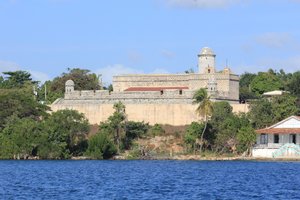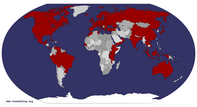Advertisement
Published: March 16th 2017

 Castillo de Jagua
Castillo de Jagua
Castillo de Jagua outside CienfuegosTouring Cuba
When we were in Cuba we also wanted to visit several places outside Havana. It turned out that it was slightly more difficult to get around than we expected. Bus tickets were often sold out several days in advance and trains in Cuba are most of the times scarce, unreliable and slow. Therefore we often had to take so called collectivo when we went from one place to the next.
Collectivo is when people go together and arrange transport by sharing a taxi. It can also be someone who has a private car and is going to drive from one city to the next and pick up paying passengers to share the costs for the ride.
Whenever we wanted to go from one place to another it was a constant struggle to try to find bus tickets. When we failed that it was a new struggle to find a collective and to negotiate a price. All this took time, slowed us down and also forced us to change plans several times. We had to visit the various places in a different order than we originally had planned just because we

 Benny Moré statue
Benny Moré statue
Benny Moré was a singer and band leader who came from and lived in Cienfuegos. We understand that he is a big name locally. Benny Moré is probably as important for Cienfuegos as Frank Sinatra is for Hoboken couldn’t find transport.
We did look into the possibility to hire a car but decided to scrap that idea when we learned that it is quite expensive. Had we been three or four sharing the costs it could have been a good idea but since there were only the two of us it wasn't worth it. We did actually try to hire a car for just a day when we were in Viñales but there were no cars available then.
We did manage to visit several places outside Havana, so it is possible to travel around. It’s just that it took a bit more time than we expected and was a bit more of a struggle than we were used to.
The first place we stopped in after leaving Havana was the city
Cienfuegos. It is a nice a pleasant city, on the south coast, with a well preserved city centre dating back to colonial times. The city centre is such a good example of colonial architecture that UNESCO has put it on its world heritage list.
Some of the things we saw in Cienfuegos were
-

 Cathedral
Cathedral
The Cathedral in Cienfuegosa
Benny Moré statue. Benny Moré was a singer and band leader who came from and lived in Cienfuegos. We had never heard of him before we came to Cuba but we understand that he is a big name locally. Benny Moré is probably as important for Cienfuegos as Frank Sinatra is for Hoboken
- Teatro Tomás Terry – we only saw this beautiful theatre from the outside. The fee for bringing a camera into the theatre, the equivalent of five dollars on top of the entrance fee, was totally outrageous so we didn’t go in at all. Fortunately we were able to visit another similar looking theatre in Santa Clara a few days later.
- The cathedral
-
Castillo de Jagua – Castillo de Jagua is an 18th fortress a few kilometers outside Cienfuegos. Again they had an entrance fee we found to high so again we decided not to go in. We could see what we came to see from the outside so instead we took a walk in, Ciudad Nuclear, a town near the fortress.
- Ciudad Nuclear – In the 1980-ies the Cubans, with help from Soviet Union, started to build a nuclear power plant

 Rancho Luna
Rancho Luna
A nice beach on the way between Castillo de Jagua and Cienfuegos. outside Cienfuegos. When Soviet Union collapsed in 1991 the project was halted and was never restarted again. Four kilometres or so away from the power plant they built a town called Ciudad Nuclear, Nuclear City. The town was first the home of the workers who constructed the power plant. Later it was thought that the personnel in the power plant would live there. However, as the power plant was never finished Ciudad Nuclear today is a strange place. It’s like the town was first abandoned and then repopulated with people who didn’t have any other place to live. Think trailer park, but everybody live in apartments.
- Rancho Luna – A nice beach on the way between Castillo de Jagua and Cienfuegos.
After Cienfuegos we went to
Trinidad, another town on the Cuba’s south coast with a colonial city centre which has made its way into UNESCO’s world heritage list. Trinidad is slightly different from Cienfuegos. Trinidad was a French colony and the French built their colonial cities in a different style than the Spanish did. At least that is what we have been told. We couldn’t see this alleged difference.
From Trinidad

 Rancho Luna
Rancho Luna
A nice beach on the way between Castillo de Jagua and Cienfuegos. we took a day trip to
Valle de los Ingenios. Valle de los Ingenios are three connecting valleys which during the 19th century was an important centre for the sugar industry. There were hundreds of plantations and at the peak over 70 sugar mills could be found there. In the 1950-ies the sugar production moved elsewhere and the sugar mills all closed down. The tour was by train and it went from Trinidad railway station to one of the abandoned sugar mills in the valley. We wanted to see one of the old sugar mills and learn a bit about the sugar industry and how it has affected life in the valley. We thought the sugar mill we visited on this tour was going to be well preserved but we were wrong. It was at best a ruin. The tour was not bad but it didn’t meet our expectations.
Santa Clara was our next stop on our improvised Cuba tour. For people who are interested in the Cuban Revolution Santa Clara is a compulsory stop. For the rest of us, well the city has a great importance in modern history of Cuba so it makes sense to make a stop as

 Teatro Tomás Terry
Teatro Tomás Terry
Teatro Tomás Terry in Cienfuegos. We only saw this beautiful theatre from the outside. The fee for bringing a camera into the theatre was too high so we didn’t go in.well.
Possibly the most
important battle during the Cuban Revolution took place in Santa Clara. In the end of 1958 revolutionaries with great success attacked a military train. The attack took place in central Santa Clara and one of the key parts of the attack was the use of a bulldozer to derail the train. At the site of the attack there is today a monument where they on a concrete platform have the actual bulldozer on display.
Earlier we mentioned that we didn’t bother to visit the theatre in Cienfuegos because the entrance fee was too high. Luckily for us there was a similar looking theatre, Teatro la Caridad, in Santa Clara we could visit instead.
One of the highlights in Santa Clara is a memorial, museum and an adjoining cemetery all dedicated to soldiers who fought in the Cuban Revolution. One of those buried in the in the memorial is Ernesto “Che” Guevara. We weren’t permitted to take photos of the grave so unfortunately we can’t show you any.
In Santa Clara there are in many places cartoon style pictures painted on walls and buildings. We don’t

 Plaza Major, Trinidad
Plaza Major, Trinidad
Plaza Major in Trinidadwant to call it graffiti because it is not a proper way to describe it. Most of these cartoons were humoristic. Some we understood but many of them required better knowledge of Spanish than we have to get the jokes.
If you look at a map over Cuba you can see that our next stop,
Viñales, is not a logical choice after Santa Clara. But we ended up there partly due to the difficulties we mentioned earlier with finding bus tickets. Things we saw in Viñales include
- Cueva del Indio – a cave open to the public.
- Mural de la Prehistoria – a supersized mural painted on a cliff. It is a modern painting but the style is similar to what you might see in ancient cave paintings.
The last place we went to in Cuba before we returned to Havana and started to prepare ourselves for the flight back home is to the Cubans known by the names Playa Larga and Playa Giron but most foreigners refer to it as
Bay of Pigs.
Bay of Pigs became famous in the early 1960-ies when the CIA
attempted to invade Cuba using Cubans

 Trinidad
Trinidad
Trinidad is a town on the Cuba’s south coast with a colonial city centre. living abroad as mercenaries. This invasion failed and Bay of Pigs and became a rather embarrassing event for the US.
The only invasion related attraction we visited in the area is a Bay of Pigs Invasion Museum in Playa Giron.
The main towns in the area are Playa Larga and Playa Giron. “Playa” means “beach” and it is no coincident that the names of the towns include the word “beach” because Bay of Pigs is lined with nice beaches and several beach resorts.
Normally we don’t spend time in beach resorts but when we visted Bay of Pigs we made an exception. We spent half a day in a place called Caleta Buena and we enjoyed it. At Caleta Buena you pay a fee to get into the resort for the day. Once you are inside all food and drinks are free of charge. We hoped to find some good snorkelling in the lagoon next to the resort but it was less good than we hoped for. But in spite of the uninspiring snorkelling we enjoyed Caleta Buena.
Outside Playa Larga there is a large wetland and bird

 Trinidad
Trinidad
Trinidad was a French colony and the French built their colonial cities in a different style than the Spanish did. At least that is what we have been told. We couldn’t see this alleged difference.sanctuary called the
Zapata Swamp. We enjoy nature scenery so we took a tour into Zapata Swamp. Bird watching is not something we normally do but one of the birds in Zapata Swamp is the Flamingo and you don’t have to be a bird watcher to enjoy seeing them. It is impossible to resist a pink bird, isn't it?
If you who read this are thinking about going to Cuba and would like to get advice on where to go and which route our advice is read a guidebook, make plan, expect delays, don’t get upset if your travels are slower than expected and be prepared to change your plans if things don’t work out the way you wanted them to. If we were to make the same trip again, don’t ask us why we would do that because we have seen everything there is to see there, we would go to the various places in a different order. We would make the following route,
Havana – Viñales – Playa Larga/Playa Giron – Cienfuegos – Trinidad – Santa Clara – Havana
which probably would have been more time efficient than the one

 Iglesia de la Santisima
Iglesia de la Santisima
The church Iglesia de la Santisima Trinidadwe actually took.
We finish here today. If you liked to read this we can tell you that our intention is to publish three more blogs from Cuba after this.
Advertisement
Tot: 0.13s; Tpl: 0.02s; cc: 14; qc: 37; dbt: 0.0522s; 1; m:domysql w:travelblog (10.17.0.13); sld: 1;
; mem: 1.2mb






























Rainyb
Lorraine Brecht
Pretty. Love the colors!